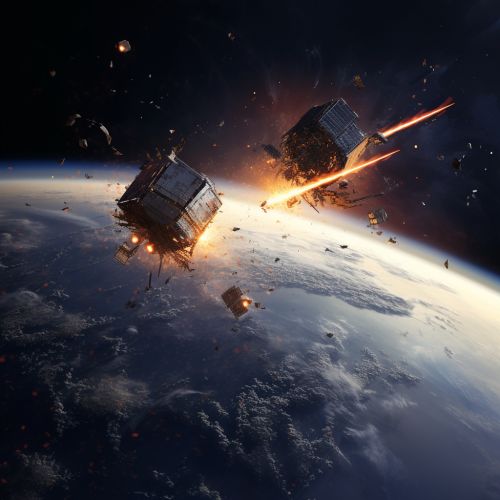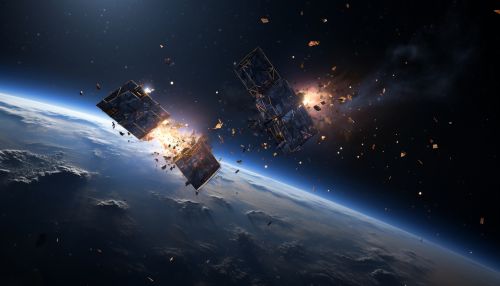Satellite collision
Introduction
A satellite collision is an event where two satellites collide in space. This is a significant concern in the field of space debris and orbital mechanics, as the increasing number of satellites in orbit can lead to an increased likelihood of collisions. These events can have serious consequences, including the creation of additional space debris and the potential loss of valuable satellite services.


Causes of Satellite Collisions
Satellite collisions can occur due to a variety of reasons. One of the primary causes is the increasing congestion of satellites in popular orbits, particularly in Low Earth Orbit (LEO) and Geostationary Orbit (GEO). These orbits are desirable for many types of satellite applications, leading to a high density of satellites and increasing the risk of collision.
Another major cause of satellite collisions is the presence of space debris. This debris can include defunct satellites, spent rocket stages, and fragments from previous collisions or explosions. These pieces of debris can travel at high speeds, and even small pieces can cause significant damage if they collide with an operational satellite.
Finally, satellite collisions can also occur due to failures in satellite navigation or control systems. These failures can cause a satellite to deviate from its intended orbit, potentially leading it into the path of another satellite.
Consequences of Satellite Collisions
The consequences of a satellite collision can be severe. The immediate result of a collision is typically the destruction or severe damage of the involved satellites. This can lead to the loss of valuable services provided by these satellites, such as telecommunications, weather monitoring, or scientific research.
In addition to the loss of the satellites themselves, a collision also creates a significant amount of space debris. This debris can pose a threat to other satellites in orbit, potentially leading to further collisions. This phenomenon, known as the Kessler Syndrome, represents a significant long-term threat to space operations.
Furthermore, satellite collisions can also have significant financial implications. Satellites are expensive to build and launch, and a collision can result in the loss of a significant investment. Additionally, the services provided by satellites often have substantial economic value, and their loss can have wide-ranging impacts.
Prevention and Mitigation of Satellite Collisions
Given the serious consequences of satellite collisions, significant efforts are made to prevent and mitigate these events. One of the primary methods of collision prevention is through the use of conjunction analysis. This involves predicting the paths of satellites and space debris to identify potential collisions. If a potential collision is identified, it may be possible to alter the course of one or more of the satellites to avoid the collision.
Another important aspect of collision prevention is the control and mitigation of space debris. This can involve a variety of strategies, including the design of satellites to minimize the creation of debris, the use of end-of-life disposal strategies to remove defunct satellites from orbit, and the development of technologies for the active removal of space debris.
Finally, international cooperation and regulation play a crucial role in preventing satellite collisions. This includes the development and enforcement of international standards and best practices for satellite design, operation, and disposal. It also involves cooperation in the sharing of data and information to improve conjunction analysis and collision prediction.
